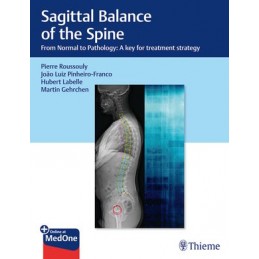- Obniżka


 Dostawa
Dostawa
Wybierz Paczkomat Inpost, Orlen Paczkę, DHL, DPD, Pocztę, email (dla ebooków). Kliknij po więcej
 Płatność
Płatność
Zapłać szybkim przelewem, kartą płatniczą lub za pobraniem. Kliknij po więcej szczegółów
 Zwroty
Zwroty
Jeżeli jesteś konsumentem możesz zwrócić towar w ciągu 14 dni*. Kliknij po więcej szczegółów
Unique resource from internationally renowned experts details the key role of sagittal spine balance
Through evolution, human verticality became associated with a wide range of normal pelvic shapes and associated pelvic incidence angles (PIs). While all types of sagittal alignment generally provide adequate support to young adults, age, stress, and related degeneration can progressively lead to sagittal imbalance and contribute to various spinal pathologies.
Sagittal Balance of the Spine by Pierre Roussouly, Jo?o Luiz Pinheiro-Franco, Hubert Labelle, Martin Gehrchen, and a cadre of esteemed international contributors focuses on the importance of sagittal alignment and spino-pelvic shape identification in clinical practice. Offering the most comprehensive text on sagittal balance to date, this state-of-the-art, richly illustrated book fills a void in the literature, offering clinical pearls throughout seven sections and 24 chapters.
Key Highlights
This text is essential reading for every neurosurgical and orthopaedic resident, as well as veteran surgeons who evaluate and treat patients with spine conditions. Clinicians will learn why incorporating sagittal balance evaluations into spinal exams is integral to devising more effective treatment strategies and achieving improved outcomes.
This book includes complimentary access to a digital copy on https://medone.thieme.com.
Opis
I Introduction to Sagittal Balance
1 Historical Background of Spinal Sagittal Balance
2 The Acquisition of Human Verticality
II Biomechanics of Sagittal Balance
3 From the Head to the Feet: Anatomy of the Upright Position
4 Modeling of the Spine
5 Sagittal Balance: The Main Parameters
6 Spinal Curves Segmentation and Lumbar Lordosis Classification
III Normative Values Following Age and Populations
7 Normative Values of Sagittal Balance in Children and Adults
8 Sagittal Balance in the Elderly
IV The Sagittal Balance of the Spine in Pathology
9 Local Stresses: Segmental Mechanism of Low Back Pain and Degeneration, and Stresses According to Spinal Orientation—Contact Forces Theory
10 Mechanisms of Spinal Degeneration According to Spinopelvic Morphotypes
11 Sagittal Imbalance Compensatory Mechanisms
V The Non Scoliotic Spine
12 Isthmic Lytic Spondylolisthesis—The Physiopathology, Classification, and Treatment Better Explained by the Sagittal Balance
13 Degenerative Spondylolisthesis: Does the Sagittal Balance Matter?
14 The Degenerative Aging Spine: A Challenge for Contemporaneous Societies
15 Scheuermanns Kyphosis
16 Cervical Sagittal Alignment and Cervicarthrosis
17 Advantages and Limitations of the SRS-Schwab Classification for Adult Spinal Deformity
VI Adolescent Idiopathic Scoliosis (AIS)
18 Specificities in Growing Spine
19 Sagittal Balance Incidence on Treatment Strategy in AIS
VII Adult Scoliosis (AS)
20 From Pathological to Normal Shapes in Adult Scoliosis
21 Sagittal Balance Treatment Strategy in a Posterior Approach
22 Adult Scoliosis Treatment with an Anterior Approach
23 Techniques for Spine Osteotomies and Clinical Applications
24 Surgical Failures Mechanisms and Their Treatment
Indeks: 92895
Autor: Michael Sabel
Indeks: 94309
Autor: Manas Panigrahi
Indeks: 80238
Autor: Robert A. Dickson
